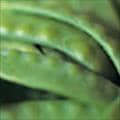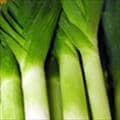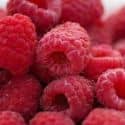Fruits and Vegetables High in Iron

Iron is an essential mineral used to transport oxygen around the body in the form of hemoglobin. A slight deficiency of iron causes anemia (fatigue/weakness), and a chronic deficiency can lead to organ failure.
Conversely, too much iron leads to the production of harmful free radicals and interferes with metabolism causing damage to organs like the heart and liver. Iron which comes from fruits and vegetables is well regulated by the body, so overdose is rare and usually only occurs when people take supplements.
Contrary to popular belief, fruits and vegetables can be a good source of iron. In addition, vitamin C is abundant in fruits and vegetables, and helps increase the absorption of iron into the body.
Fruits and vegetables high in iron include dried fruits, dark leafy greens, podded peas, asparagus, button mushrooms, acorn squash, leeks, dried coconut, green beans, and raspberries. The current daily value (DV) for iron is 18 milligrams (mg).
Below is a list of fruits and vegetables high in iron, for more, see the extended list of iron rich fruits and vegetables, and the top 10 vegetarian foods highest in iron.
List of Fruits and Vegetables High in Iron
 1 Dried Fruit (Apricots)
1 Dried Fruit (Apricots)| Iron per Cup | Iron per 100g | Iron per 200 Calories |
|---|---|---|
| 8mg (42% DV) | 6mg (35% DV) | 4mg (22% DV) |
More Dried fruit High in Iron
- 36% DV per cup of dried peaches
- 26% DV per cup of dried prunes and currants
- 24% DV per cup of dried raisins
- 21% DV per cup of dried pears
- 17% DV per cup of dried figs
- 7% DV per cup of dried apples
Note: Dried fruit is high in natural sugars, so should be eaten in moderate servings of around 1 handful per day.
 2 Spinach
2 Spinach| Iron per Cup Cooked | Iron per 100g | Iron per 200 Calories |
|---|---|---|
| 6mg (36% DV) | 4mg (20% DV) | 31mg (172% DV) |
Other Greens High in Iron
- 22% DV per cup of cooked Swiss chard
- 16% DV per cup of cooked turnip greens
- 6% DV per cup of raw chopped kale
- 5% DV per cup of raw chopped beet greens
 3 Podded Peas
3 Podded Peas| Iron per Cup | Iron per 100g | Iron per 200 Calories |
|---|---|---|
| 3mg (18% DV) | 2mg (11% DV) | 9mg (52% DV) |
- Lima beans provide 23% DV of iron per cup
 4 Asparagus
4 Asparagus| Iron per Cup | Iron per 100g | Iron per 200 Calories |
|---|---|---|
| 3mg (16% DV) | 2mg (12% DV) | 21mg (119% DV) |
A cup of asparagus contains just 27 calories.
 5 White Button Mushrooms
5 White Button Mushrooms| Iron per Cup Cooked | Iron per 100g | Iron per 200 Calories |
|---|---|---|
| 3mg (15% DV) | 2mg (10% DV) | 12mg (69% DV) |
Other Mushrooms High in Iron
- 45% DV per cup of cooked morels
- 6% DV per cup of cooked oyster mushrooms
- 3% DV per cup of shiitake
 6 Acorn Squash
6 Acorn Squash| Iron per Cup Cooked | Iron per 100g | Iron per 200 Calories |
|---|---|---|
| 2mg (11% DV) | 1mg (5% DV) | 3mg (18% DV) |
Pumpkin provides 7% DV per cup, most other winter squash provide 6% DV per cup.
 7 Leeks
7 Leeks| Iron per Cup | Iron per 100g | Iron per 200 Calories |
|---|---|---|
| 2mg (10% DV) | 2mg (12% DV) | 7mg (38% DV) |
Scallions (spring onions) are also high in iron with (2% DV) per onion.
 8 Dried Coconut
8 Dried Coconut| Iron per Oz | Iron per 100g | Iron per 200 Calories |
|---|---|---|
| 1mg (5% DV) | 3mg (19% DV) | 1mg (6% DV) |
Other Coconut Products High in Iron
- 5% DV per ounce of toasted desiccated (dried) coconut
- 5% DV per ounce of creamed coconut
- 5% DV per ounce of coconut milk
 9 Green Beans
9 Green Beans| Iron per Cup | Iron per 100g | Iron per 200 Calories |
|---|---|---|
| 1mg (5% DV) | 1mg (4% DV) | 5mg (26% DV) |
See more vegetarian foods high in iron.
 10 Raspberries
10 Raspberries| Iron per Cup | Iron per 100g | Iron per 200 Calories |
|---|---|---|
| 1mg (5% DV) | 1mg (4% DV) | 3mg (15% DV) |
Other Berries High in Iron
- 14% DV per cup of Mulberries
- 13% DV per cup of Elderberries
- 9% DV per cup of Raspberries
- 7% DV per cup of Blackberries
- 6% DV per cup of Strawberries
- 5% DV per cup of Raspberries
- 5% DV per cup of Blackberries
- 5% DV per cup of Longanberries
- 5% DV per cup of Wild Blueberries
Printable One Page Sheet

Even More Iron Rich Fruits and Vegetables
| Food | Serving | Iron |
|---|---|---|
| 1 Lemon Grass (Citronella) | 1 cup | 30% DV (5mg) |
| 2 Palm Hearts | 1 cup | 25% DV (5mg) |
| 3 Passion-Fruit (Granadilla) | per cup | 21% DV (4mg) |
| 4 Parsley | per cup | 21% DV (4mg) |
| 5 Succotash | 1 cup | 16% DV (3mg) |
| 6 Horned Melon (Kiwano) | 1 cup | 15% DV (3mg) |
| 7 Lentil Sprouts | per cup cooked | 14% DV (2mg) |
| 8 Sauerkraut | 1 cup | 12% DV (2mg) |
| 9 Dandelion Greens | per cup | 9% DV (2mg) |
| 10 Artichokes (Globe or French) | in a medium artichoke | 9% DV (2mg) |
| 11 Groundcherries | 1 cup | 8% DV (1mg) |
| 12 Mamey Sapote | 1 cup chopped | 8% DV (1mg) |
| 13 Avocados | per Avocado | 6% DV (1mg) |
| 14 Lettuce | per cup | 4% DV (1mg) |
| 15 Olives | 1 large | 3% DV (0mg) |
Factors which Affect Iron Absorption and Retention
- The most important factor is your existing iron level. A low iron level will increase absorption, while a high iron level will decrease absorption. In general, you absorb 10-15% of the iron from foods. (2)
- Meat proteins will increase the absorption of non-heme iron. (2)
- Vitamin C will increase the absorption of non-heme iron by as much as 85%. (2,3)
- Tannins, oxalates, polyphenols, and phytates found in tea and coffee can reduce the absorption of non-heme iron by up to 65%. Black tea reduces absorption more than green tea and coffee. (2,3,4)
- The following teas and beverages also inhibit iron absorption: Peppermint tea, cocoa, vervain, lime flower, chamomile, and most other herbal teas containing polyphenols. (4)
- Calcium, polyphenols, and phytates found in legumes, whole grains, and chocolate can reduce absorption of non-heme iron. (2) Further milk, and antacids can inhibit absorption of iron supplements. (5)
- Some proteins from soy products may inhibit non-heme iron absorption. (2)
- High fiber foods, such as whole grains, raw vegetables, and bran can inhibit absorption of iron supplements. (5)
- Foods or drinks containing caffeine can inhibit absorption of iron supplements. (4, 5)
Causes of Iron Deficiency
- Menstruating Women - Due to blood loss during menstruation, women are at risk of iron deficiency. The greater the blood loss the greater the risk. (2)
- Individuals with Kidney Failure - People with kidney failure, and especially those on dialysis, are at high risk of iron deficiency anemia. This is due to an inability of the kidney to create adequate amounts of the hormone erythropoietin which is necessary for red blood cell creation, and therefore, retaining iron. (2)
- Pregnant and lactating women - A developing fetus requires a high amount of iron, likewise, there is a high amount of iron lost through breast milk after birth. (2)
- Older infants and toddlers - Infants and toddlers require a lot of iron as they grow and so are at risk of iron deficiency. (2)
- People with low levels of Vitamin A - Vitamin A helps move iron from storage in the body. Without adequate amounts of vitamin A, the body cannot regulate iron leading to an iron deficiency. (2)
- People with gastrointestinal disorders - Diarrhea, ulcers, and other gastrointestinal disorders and diseases can lead to an inadequate iron absorption. (2)
- Cancer - 60% of patients with colon cancer are iron deficient. 29-46% of patients with other cancers are also deficient in iron. (2)
- People with Gastrointestinal Disorders - People on a restricted diet, or who have problems absorbing nutrients are at risk of iron deficiency. This includes people after bypass surgery. (2)
- People with Heart Failure - Around 60% of people with heart failure are iron deficient. (2)
About the Data
Data for the curated food lists comes from the USDA Food Data Central Repository.
You can check our data against the USDA by clicking the (Source) link at the bottom of each food listing.
Note: When checking data please be sure the serving sizes are the same. In the rare case you find any difference, please contact us and we will fix it right away.
About Nutrient Targets
Setting targets can provide a guide to healthy eating.
Some of the most popular targets include:- Daily Value (%DV) - The daily value (%DV) is a general guideline for consumption that will prevent deficiency of a particular nutrient in most people. The %DV refers to the percentage of an amount that's found in a single serving of a food. It also accounts for absorption factors. It is set by the U.S. FDA.
- Recommended Dietary Allowance (%RDA) - The RDA sets an average daily dietary intake level that is sufficient to meet the nutrient requirements of nearly all (97.5%) healthy individuals. It's more specific than the daily value, and varies by age and gender. The RDA is set by the US National Instutites of Health.
- Reference Dietary Intake (%RDI) -The reference dietary intake is similar to the recommended daily allowance, but is specific to age and gender. The RDI for amino acids is set by the U.N. World Health Organization.
- Adequate Intake (%AI) - This value is primarily used in reference to omega-3 and omega-6 fats. The Adequate Intake is set by the U.S. Institute of Medicine. Because there is less evidence to determine the ideal targets for consumption of these nutrients, the specific amount is considered to be less reliable. Using the term Adequate Intake, rather than one of the other terms, helps to emphasize that the ideal intake of that particular nutrient has not yet been scientifically determined.
See the Guide to Recommended Daily Intakes for more information.
Want to set your own targets? Sign up for an account and set custom targets in the daily meal planner.From the Nutrient Ranking Tool
Use the ranking tool links below to select foods and create your own food list to share or print.
- Foods High in Iron
- Foods Low in Iron
- Vegetables High in Iron
- Fruits High in Iron
- Vegetarian Foods High in Iron
- Nuts High in Iron
- Grains High in Iron
- Beans High in Iron
- Dairy High in Iron
- Breakfast Cereals High in Iron
- Fast Foods High in Iron
View more nutrients with the nutrient ranking tool, or see ratios with the nutrient ratio tool.
Related
Data Sources and References
- U.S. Agricultural Research Service Food Data Central
- Office of Dietary Supplements Fact Sheet: Iron
- Hallberg L, Rossander L. Effect of different drinks on the absorption of non-heme iron from composite meals. Hum Nutr Appl Nutr. 1982 Apr;36(2):116-23.
- Richard F. Hurrell, Manju Reddy, and James D. Cook. Inhibition of non-heme iron absorption in man by polyphenolic-containing beverages. British Journal of Nutrition (1999), 81, 289-295
- National Library of Medicine Fact Sheet on Taking Iron Supplements.
Try the recipe nutrition calculator, or daily meal planner.
Create a free account to log and track foods.
